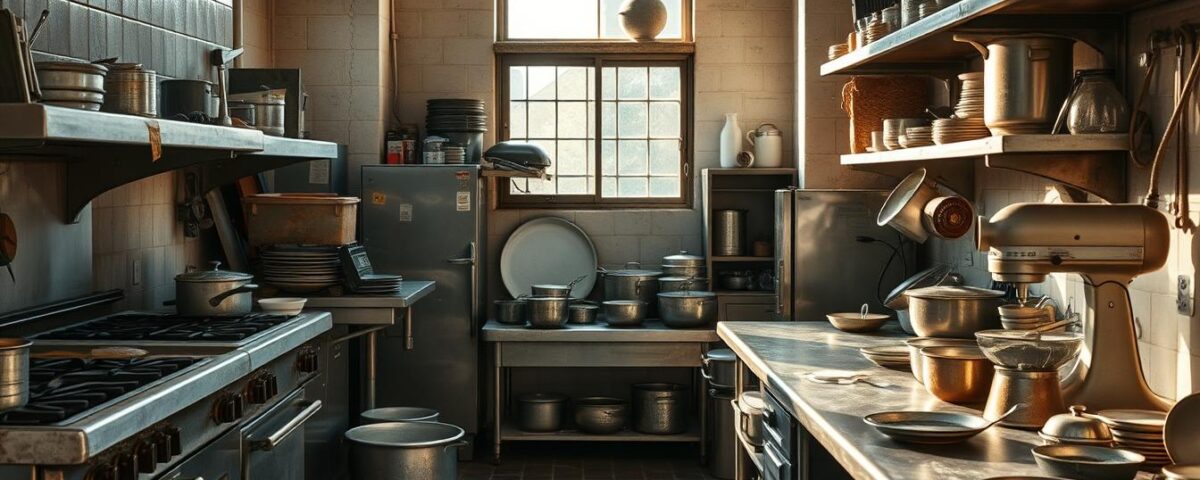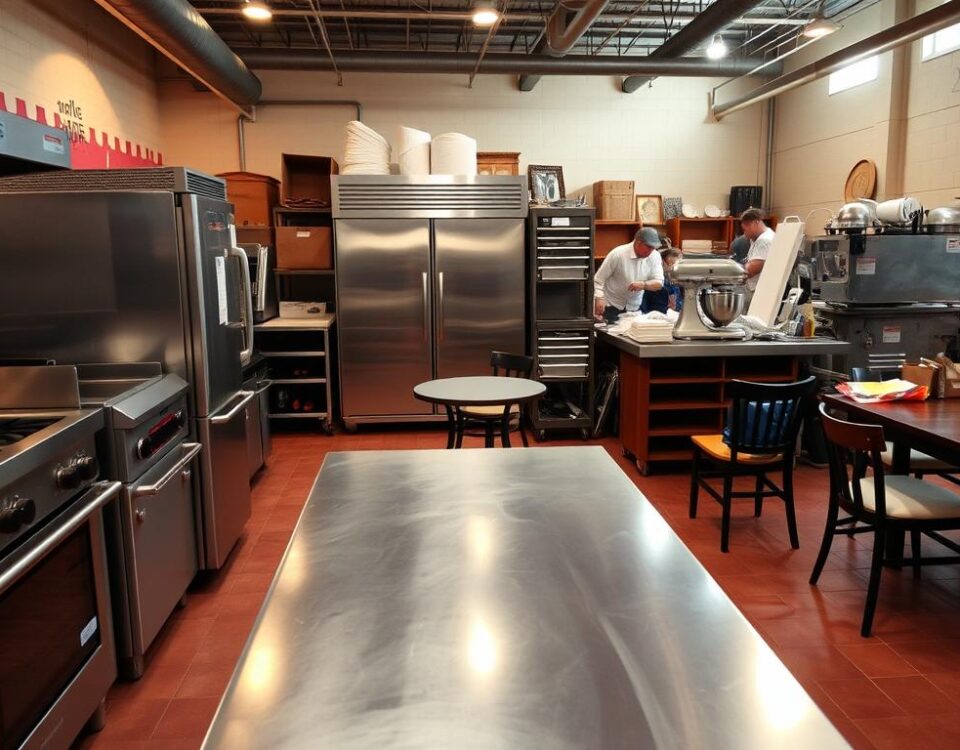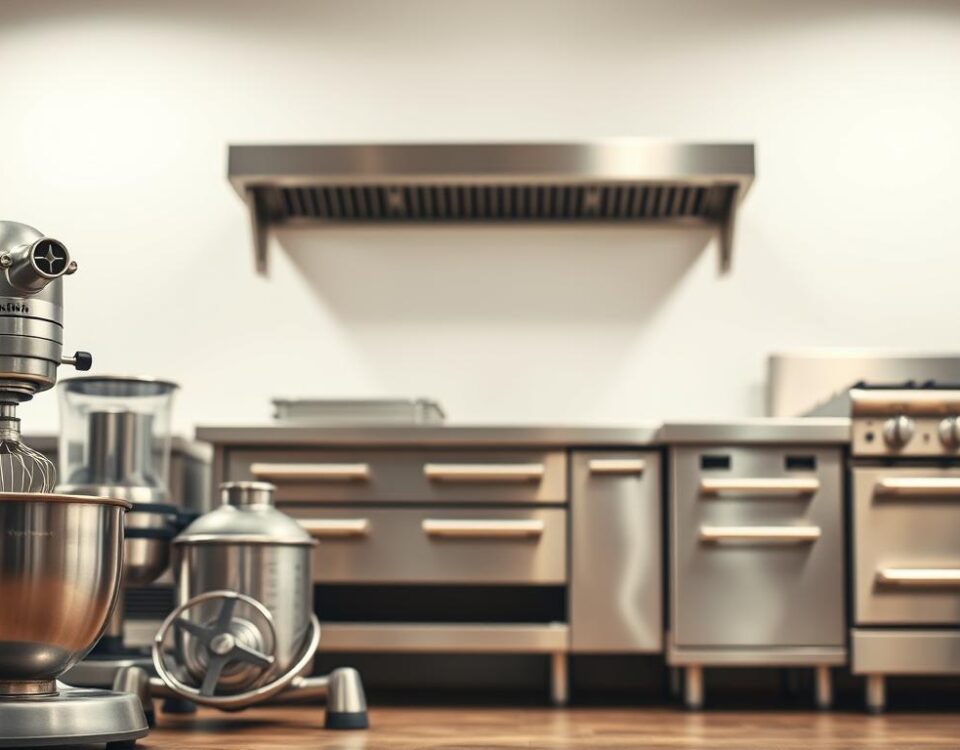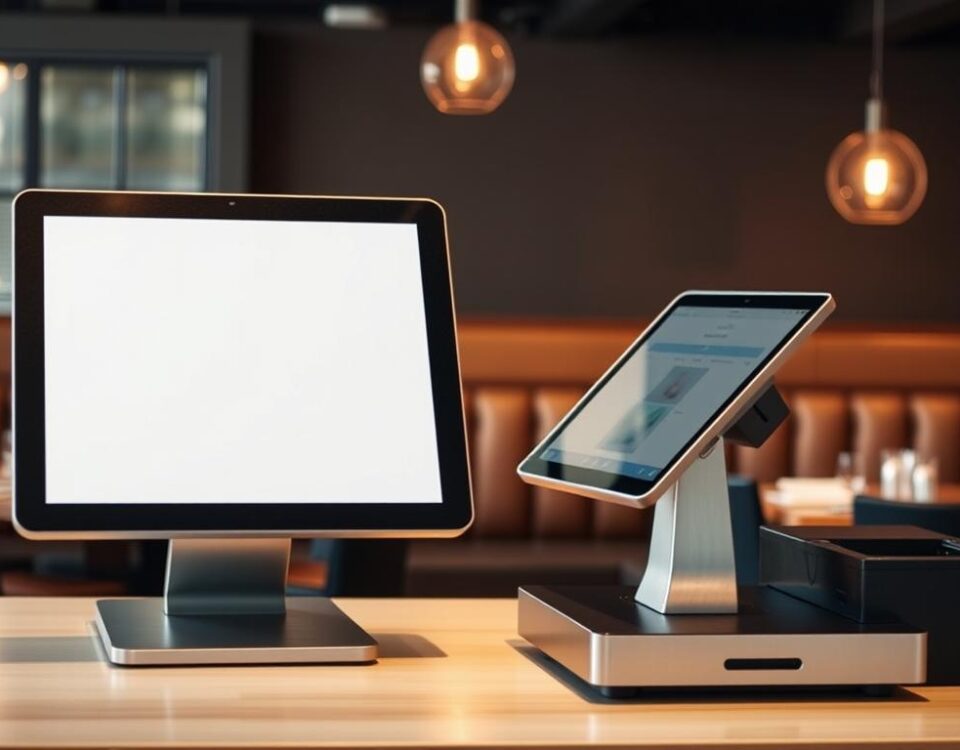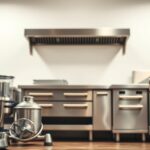
What to Ask Before Buying from a Restaurant Supply Store
October 2, 2025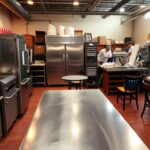
Restaurant Auction Buying Guide: Get the Best Deals
October 3, 2025When I decided to open my own restaurant, I was determined to cut costs wherever possible. Buying used restaurant equipment seemed like a great way to save money, but I wasn’t sure what to expect.
I was surprised to learn that the used restaurant equipment market is growing rapidly, with a projected growth from $5.9 billion in 2023 to $6.34 billion in 2024. This growth is driven by the appeal of cost-effective solutions and a focus on sustainability.
As I navigated this market, I encountered both successes and challenges. In this article, I’ll share my experience and provide practical advice on how to assess equipment condition and negotiate effectively with sellers. What I learned may surprise you.
Key Takeaways
- The used restaurant equipment market is growing rapidly, driven by cost-effectiveness and sustainability.
- Buying used equipment can result in significant cost savings, but it’s crucial to assess the condition carefully.
- Understanding typical lifespans of equipment is key to making informed purchasing decisions.
- Negotiating effectively with sellers can make a big difference in the overall cost.
- Exploring various sources, including online marketplaces and restaurant auctions, can help you find reliable used equipment.
My Journey into the World of Used Restaurant Equipment
As I embarked on opening my first restaurant, I found myself navigating the complex world of used restaurant equipment. The process was both challenging and enlightening, as I weighed the pros and cons of buying second-hand equipment for my commercial kitchen.
Why I Decided to Explore Used Equipment Options
The initial investment required for new commercial kitchen equipment was staggering, prompting me to explore alternatives. I discovered that many successful restaurant owners opt for used equipment to manage costs without compromising on quality. This realization was a turning point in my decision-making process.
I began researching industry trends and found that buying used equipment could significantly reduce my startup expenses. The prospect of acquiring high-quality, pre-owned equipment at a fraction of the initial purchase price was particularly appealing.
Setting a Budget and Initial Expectations
I set a realistic budget for used equipment, aiming to spend about 40% of what I would have on new equipment. My initial expectations were cautiously optimistic; I hoped to find functional, clean equipment with several years of service life remaining.
I was particularly interested in sourcing equipment from recently closed high-end restaurants, as they often feature premium brands that were well-maintained. This approach required me to become knowledgeable about various equipment types, their typical lifespans, and common failure points to avoid costly mistakes.
The Significant Cost Savings I Discovered
Purchasing used restaurant equipment can result in significant cost savings, making it an attractive option for restaurants with limited budgets.
One of the most compelling reasons to buy second-hand restaurant equipment is the potential for substantial cost savings. Second-hand commercial kitchen equipment is often significantly cheaper than buying brand new, which makes a substantial difference when working with a tight budget.
Price Comparison: New vs. Used Equipment
For instance, a new commercial oven might cost $5,000, while a used one in good condition could be found for $1,500. That’s a savings of $3,500 on just one piece of equipment. When you’re outfitting an entire kitchen, these savings can add up.
The cost savings I discovered when buying used restaurant equipment were truly eye-opening—I managed to outfit my entire kitchen for less than 40% of what it would have cost new.
Where I Found the Best Deals
I found the best deals at restaurant auctions where multiple pieces were being liquidated at once, allowing me to negotiate package deals that further reduced the per-item cost.
- For high-end equipment like commercial ovens, I found that used models in good condition were typically priced at 30-35% of their original retail price.
- Refrigeration units showed similar value, with barely-used walk-in coolers available at 40-50% of new prices.
- Online marketplaces occasionally offered exceptional values, particularly when sellers needed to quickly clear out equipment.
- Equipment dealers specializing in used restaurant equipment provided more moderate savings but offered the advantage of basic testing and cleaning.
By exploring different sources and being mindful of the condition and pricing of used equipment, I was able to achieve significant cost savings on my restaurant equipment purchases.
My Used Restaurant Equipment Results: The Good Finds
I was pleasantly surprised by the excellent condition and value of the used restaurant equipment I purchased. My kitchen was fully equipped with high-quality machinery at a fraction of the cost of new equipment.
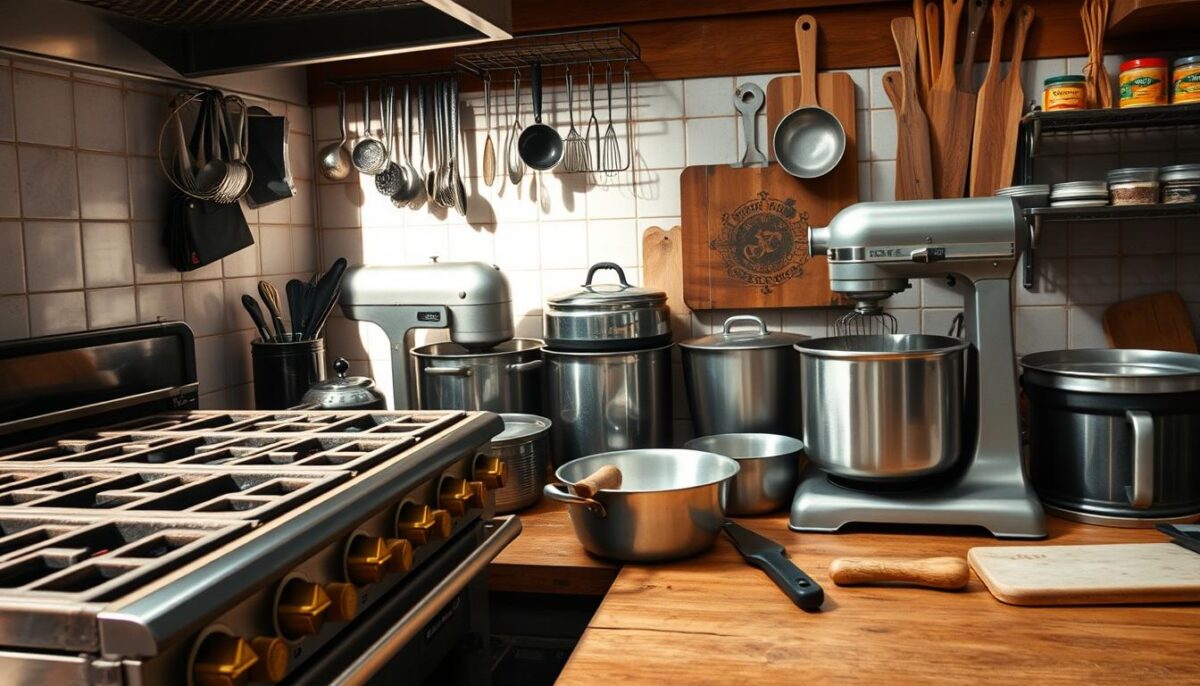
High-Quality Equipment at Fraction of Original Cost
One of my best finds was a commercial-grade six-burner range from a premium manufacturer. Although it was two years old, it was priced at just 35% of its original retail value. This range became the centerpiece of my kitchen and has performed flawlessly. I also discovered several stainless steel prep tables and shelving units that showed virtually no wear, saving me thousands of dollars while giving my kitchen a professional appearance.
The commercial refrigeration units I purchased were from a well-known brand, renowned for their durability. These units required only minor cleaning before being put to use, demonstrating the value of buying from reputable sources.
| Equipment | Original Price | Used Price | Savings |
|---|---|---|---|
| Commercial-grade six-burner range | $10,000 | $3,500 | 65% |
| Stainless steel prep tables | $5,000 | $1,500 | 70% |
| Commercial refrigeration units | $8,000 | $2,400 | 70% |
Immediate Availability and Quick Setup
The immediate availability of used equipment was a significant advantage for my project timeline. I was able to have my entire kitchen operational within two weeks of purchasing the equipment, compared to the 8-12 week lead times quoted for new equipment. This rapid deployment allowed me to avoid shipping delays common with new equipment orders, enabling me to open my restaurant on schedule.
Many of the used items I purchased came from local sources, allowing me to inspect them in person before buying and arrange quick, affordable transportation. Some of my best finds came from restaurants that had closed after only 1-2 years in business, meaning their equipment had minimal wear but was priced to sell quickly.
The Challenges I Faced with Second-Hand Equipment
Despite the advantages, I faced numerous challenges with my second-hand equipment purchases that prospective buyers should be aware of. Buying used restaurant equipment can be a cost-effective solution, but it’s essential to be aware of the potential issues that may arise.
Warranty and Support Issues
One of the most significant drawbacks of purchasing used equipment is the absence of a manufacturer’s warranty. Unlike new equipment, used equipment is typically sold “as-is,” leaving the buyer responsible for any repairs or maintenance required after the purchase. I experienced this firsthand when my used dishwasher developed a leak just three weeks after installation, and I had to cover the full cost of repairs with no manufacturer support.
Finding qualified technicians willing to work on older equipment models can be difficult, as some repair companies prefer to service only newer units they’re familiar with. This limitation can lead to additional challenges and costs in maintaining your equipment.
Hidden Problems That Emerged Later
Several pieces of equipment I purchased had hidden problems that weren’t apparent during the initial inspection but emerged after weeks of regular use. For instance, a salamander broiler I bought had intermittent heating issues that became apparent only after it was put into heavy use.
- The true cost of repairs sometimes exceeded my expectations, with parts for certain older models being surprisingly expensive or difficult to source.
- I discovered that a used refrigeration unit was actually much less energy-efficient than advertised, leading to higher utility bills that partially offset my initial savings.
- Equipment from closed restaurants sometimes has issues resulting from improper shutdown or storage, such as seals that dried out or electronics that suffered from moisture exposure.
- The lack of operational manuals and documentation for some used equipment meant I had to spend additional time researching proper usage and maintenance procedures online.
Being aware of these potential challenges can help you make more informed decisions when purchasing used restaurant equipment. While there are risks involved, taking the time to thoroughly inspect equipment and understand the potential costs and issues can help mitigate these risks.
How I Assessed Equipment Condition Before Buying
I quickly learned that evaluating the condition of used equipment was key to making a smart purchase. To mitigate the risks associated with buying used restaurant equipment without a warranty, I had to be thorough in my inspections.
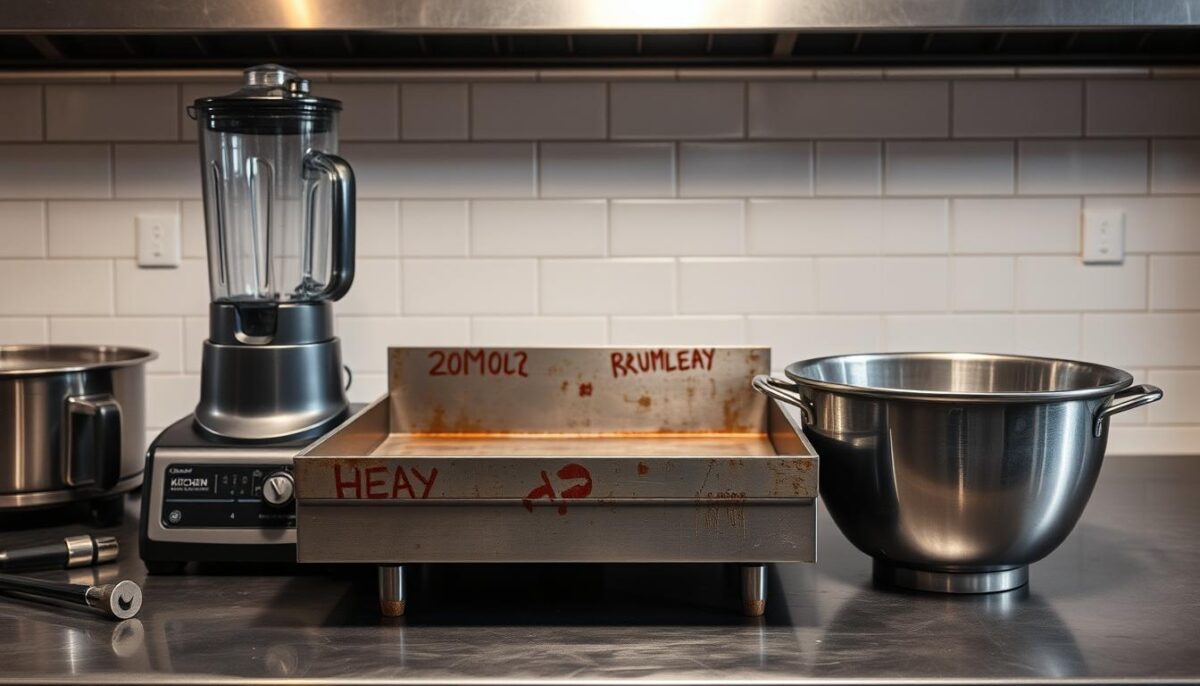
Conducting a thorough inspection involves checking various aspects of the equipment. For cooking equipment, I tested all burners, heating elements, and temperature controls to ensure they functioned properly. When examining refrigeration units, I monitored temperature readings over at least 30 minutes to verify consistent cooling.
Inspection Essentials
My inspection checklist was comprehensive, covering critical areas such as:
- Checking for signs of excessive wear, like wobbly handles or loose hinges
- Verifying the condition of door seals, compressor sounds, and drainage systems in refrigeration units
- Testing gas equipment for leaks using soapy water around connections and checking safety shutoffs
- Reviewing the equipment’s service history and previous usage patterns
Recognizing Potential Issues
During my inspections, I learned to recognize red flags that could indicate potential problems. These included:
- Evasive sellers or those reluctant to demonstrate equipment functions
- Signs of repairs, modifications, or water damage in electronic equipment
- Excessive rust in non-visible areas, indicating neglected maintenance
For complex or expensive purchases, I found it valuable to bring along a qualified technician. Their expert assessment often revealed potential issues that I might have otherwise missed.
Understanding Equipment Lifespan: What I Learned
Understanding equipment lifespan was a critical aspect of my used restaurant equipment buying experience. As I navigated the complex world of commercial kitchen equipment, I realized that the lifespan of different equipment categories varies significantly.
The longevity of equipment is influenced by factors such as maintenance, usage, and the type of equipment itself. This knowledge became crucial in making informed purchasing decisions and calculating the true value of my investments.
Cooking Equipment Longevity
Cooking equipment, such as commercial gas ranges and ovens, are among the most durable pieces of kitchen equipment. When properly maintained, they can function reliably for 15-20 years, making them excellent candidates for used purchases. However, fryers and griddles typically have shorter lifespans of 8-12 years due to intense heat and oil exposure.
Refrigeration Units: Expected Service Life
Commercial refrigeration units show significant variation in durability. Walk-in coolers can last 15+ years, while reach-in units typically need replacement after 8-10 years due to compressor wear. Ice machines have relatively short useful lives of 5-7 years before major components fail.
Dishwashing and Sanitation Equipment Durability
Dishwashing equipment surprised me with its longevity. Commercial dishwashers can function for 10-15 years with proper maintenance, though water quality and usage volume significantly impact their lifespan. Stainless steel preparation tables and shelving can last virtually indefinitely, making them safe and value-oriented used purchases.
By understanding these lifespan expectations, I was able to make more informed decisions and determine appropriate pricing based on age and condition.
The True Cost of Ownership: Beyond the Purchase Price
When evaluating the cost of used kitchen equipment, it’s essential to look beyond the initial purchase price and consider the total cost of ownership over the equipment’s lifespan. As I discovered during my journey into buying second-hand restaurant equipment, various factors contribute to the overall expense.
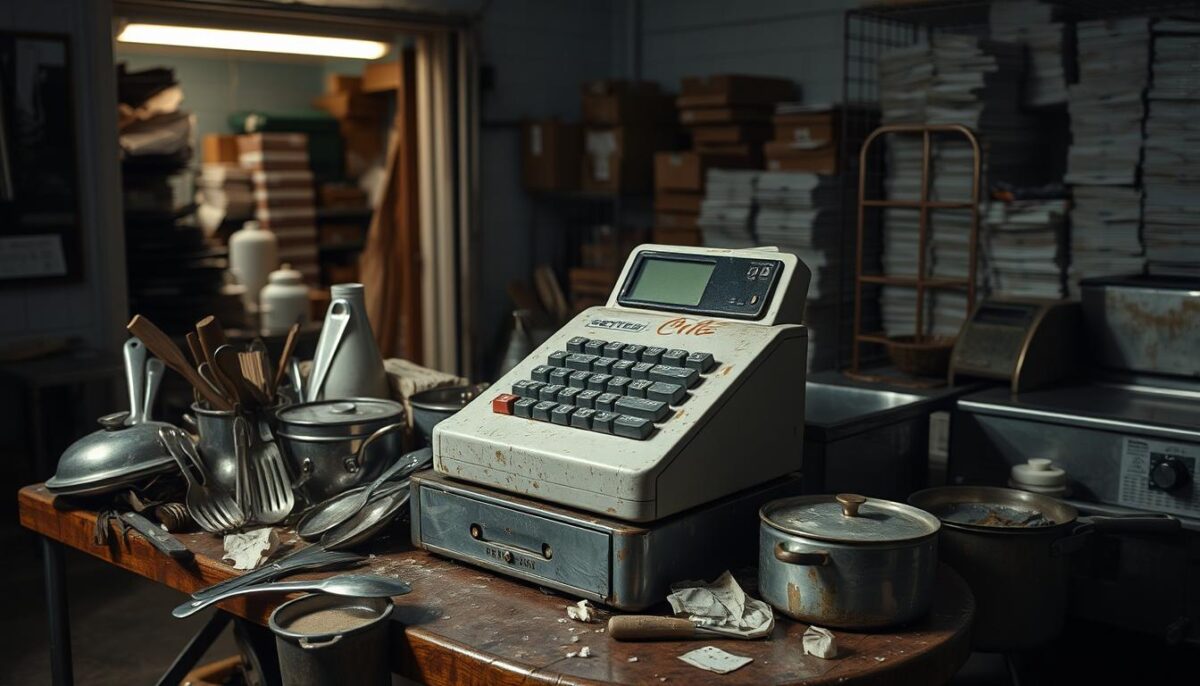
The initial purchase price of used restaurant equipment was just the beginning—I tracked all costs over the first year to understand the true cost of ownership for my second-hand purchases. Several expenses emerged that I hadn’t initially considered.
Maintenance and Repair Expenses I Encountered
Maintenance expenses varied significantly by equipment type. My used refrigeration units required the most frequent service, with quarterly maintenance costing approximately $200-300 per unit annually. Unexpected repairs also became a significant factor in the total cost equation—I spent nearly $1,800 fixing various issues across all equipment during the first year.
Establishing a relationship with a reliable service technician who specialized in restaurant equipment saved me money through preventative maintenance that avoided larger repairs. This experience taught me the importance of factoring in anticipated repair and maintenance costs when evaluating used equipment.
Energy Efficiency Considerations
I discovered that older equipment typically consumed 15-30% more energy than newer, more efficient models, adding approximately $175 monthly to my utility bills compared to if I had purchased all new energy-efficient equipment. This significant increase in energy costs was a crucial consideration in my overall cost analysis.
Despite these additional costs, my analysis showed that even after accounting for higher maintenance, repairs, and utility expenses, I still saved approximately 35% compared to if I had purchased everything new. This experience demonstrated that buying used restaurant equipment can be a cost-effective strategy when done thoughtfully.
Where to Find Reliable Used Restaurant Equipment
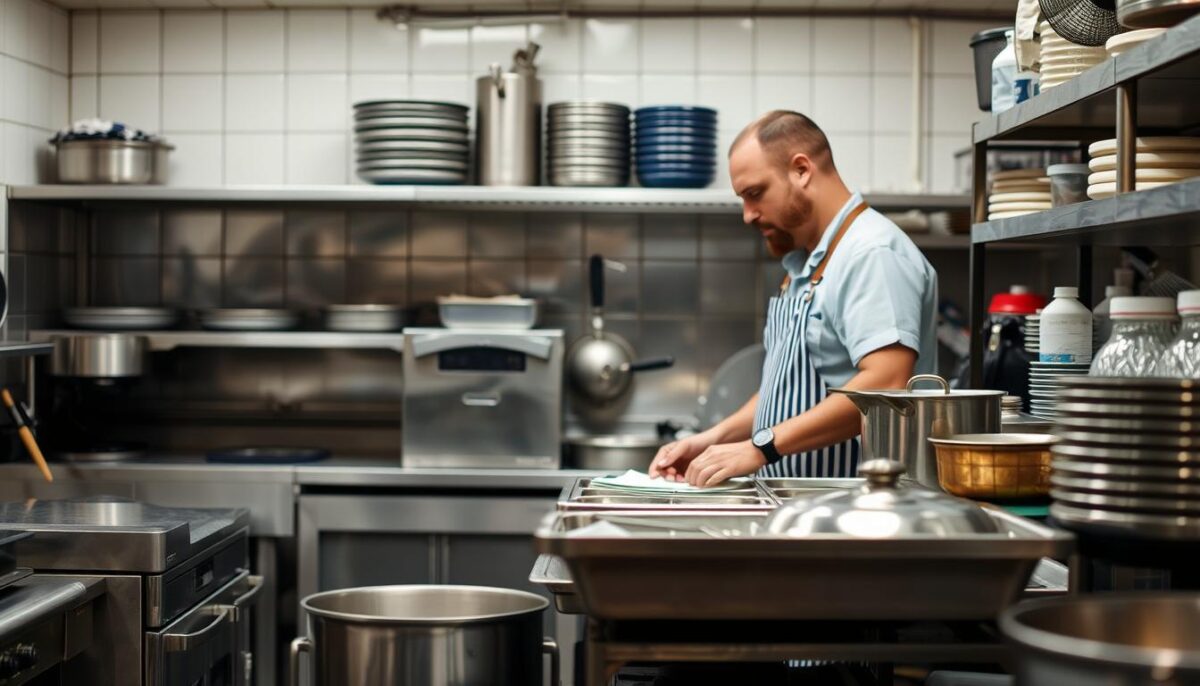
The quest for reliable used restaurant equipment led me to multiple avenues, each with its pros and cons. In my journey, I discovered that the key to finding great deals lies in knowing where to look and how to assess the condition of the equipment.
Online Marketplaces I Tried
I started my search on online marketplaces like eBay and Facebook Marketplace, which offered a wide selection of used equipment. However, I had to be cautious about the shipping costs and the credibility of the sellers. Specialized restaurant equipment sites were also helpful, providing a range of options from various suppliers.
Restaurant Auctions and Liquidations
Attending restaurant auctions proved to be a valuable experience, as I found high-quality equipment at competitive prices. The timing of these auctions was crucial, with the best deals coming from recently closed high-end restaurants or those undergoing renovations.
Equipment Dealers and Refurbishers
Local equipment dealers specializing in used restaurant equipment offered the advantage of inspecting items before purchase and sometimes provided basic warranties. I also found refurbishers who completely reconditioned specific types of equipment, offering like-new performance at a fraction of the cost of new items.
In conclusion, finding reliable used restaurant equipment requires exploring multiple sources, including online marketplaces, restaurant auctions, and local dealers. By understanding the pros and cons of each option and being mindful of factors like shipping and location, you can make informed decisions and find great deals on the equipment you need for your restaurant or kitchen.
Negotiating Tips That Saved Me Thousands
When I ventured into buying used restaurant equipment, I quickly realized that negotiation was key to getting the best deals. My experience taught me that understanding the equipment’s history and condition could significantly impact the purchase price.
Questions I Asked Sellers
To make informed decisions, I always asked sellers specific questions about the equipment’s operational history. I inquired about the number of hours it was used daily, maintenance performed, and the reason for sale. For instance, when buying a used commercial oven, I asked the seller about its maintenance history and was told it had been serviced regularly, which gave me confidence in its condition.
- How many hours per day was the equipment used?
- What maintenance had been performed on the equipment?
- Why was the equipment being sold?
Leveraging Equipment Condition in Price Discussions
I learned to identify cosmetic issues that didn’t affect the equipment’s functionality but could be used as negotiating points. For example, dents or scratches on otherwise sound equipment often led to price reductions of 10-15%. When dealing with restaurant owners selling due to business closure, offering immediate removal and cash payment resulted in significant additional discounts.
| Negotiation Strategy | Average Discount |
|---|---|
| Bundling multiple purchases | 15-20% |
| Identifying cosmetic issues | 10-15% |
| Offering immediate cash payment | 5-10% |
By employing these negotiation strategies when buying used restaurant equipment, I was able to save thousands of dollars beyond the already-reduced asking prices. Understanding the equipment’s condition and history played a crucial role in these negotiations.
Equipment Categories: My Best and Worst Purchases
My journey into buying used restaurant equipment has shown me that some categories are better suited for second-hand purchases than others. After a year of operation, I’ve identified clear patterns in which categories provided the best value and which ones I should have purchased new.
Cooking Equipment: Ranges, Ovens, and Fryers
Heavy-duty cooking equipment like commercial ranges and ovens proved to be my best used purchases. These items are built to last for decades, and the gas models I bought had simple, reliable components that rarely failed. Convection ovens were particularly good investments when purchased used, as their relatively simple construction meant fewer potential failure points.
| Equipment Type | Condition | Performance |
|---|---|---|
| Commercial Ranges | Good | Excellent |
| Convection Ovens | Fair | Good |
| Fryers | Mixed | Variable |
Refrigeration: What Worked and What Didn’t
Refrigeration equipment presented the greatest challenges. While my used reach-in coolers have performed well, the used freezer I purchased required expensive compressor repairs within six months. This experience taught me to be cautious when buying used refrigeration units.
Food Prep and Storage Solutions
Stainless steel food prep tables, shelving, and storage solutions were unquestionably the safest used purchases, offering virtually the same functionality as new items at 25-40% of the cost. Simple mechanical equipment like manual slicers and mixers were excellent used purchases, while complex electronic equipment proved more problematic.
In conclusion, while buying used equipment can be cost-effective, it’s crucial to carefully evaluate the category and condition of the equipment before making a purchase. By doing so, you can maximize the value of your investment and minimize potential issues down the line.
Compatibility Issues I Didn’t Anticipate
As I navigated the process of buying used restaurant equipment, I encountered several compatibility issues that I hadn’t anticipated. Purchasing second-hand equipment for my restaurant turned out to be more complex than I initially thought, particularly when it came to ensuring that the new equipment would work seamlessly with my existing kitchen setup.
Space and Layout Challenges
One of the primary concerns was the physical space available in my commercial kitchen. I faced significant space and layout challenges when some equipment pieces were slightly larger than their listed dimensions due to protruding handles, exhaust vents, or utility connections that weren’t accounted for in the basic measurements. This required modifying the kitchen layout multiple times to accommodate the equipment, creating workflow inefficiencies that we eventually had to address with additional modifications.
- The dimensions of used equipment can be misleading if not measured carefully.
- Protruding parts can affect the overall fit in the designated area.
- Modifying the kitchen layout can be costly and time-consuming.
Utility Connections and Requirements
Utility connections presented another set of complications. Some used gas equipment required different pressure ratings than what was initially installed in the building, necessitating expensive adjustments to the gas lines. Electrical requirements also varied widely among the used equipment I purchased, with several pieces needing dedicated circuits or voltage conversions that added significantly to the installation costs.
| Utility Type | Compatibility Issue | Resolution |
|---|---|---|
| Gas | Different pressure ratings | Adjust gas lines |
| Electrical | Dedicated circuits or voltage conversions needed | Install dedicated circuits or convert voltage |
| Water | Additional plumbing modifications required | Modify plumbing for proper drainage and supply |
By understanding these compatibility issues upfront, I could have potentially saved time and money. It’s crucial for anyone considering buying used restaurant equipment to thoroughly assess these factors to avoid similar challenges.
Conclusion: Is Buying Used Restaurant Equipment Worth It?
After diving into the world of used restaurant equipment, I’ve gained valuable insights that can help you make an informed decision. My journey has shown that buying used equipment can be a cost-effective strategy for restaurant owners, but it requires careful consideration and planning.
The financial benefits of purchasing used equipment are significant. I saved approximately 60% on my total equipment costs compared to buying new, which greatly improved my business’s cash flow during the critical startup phase. This saving allowed me to allocate more resources to other essential areas of my restaurant.
Selective purchasing is key to success with used equipment. I found that heavy-duty cooking equipment, stainless steel work surfaces, and basic refrigeration units offered the best value when bought used. On the other hand, complex electronic equipment, specialized food processing machines, and ice makers proved more problematic as used purchases and might be better bought new despite the higher initial investment.
The used restaurant equipment market is growing, projected to reach $8.51 billion by 2028. This growth means more options and potentially better quality as more high-end equipment enters the secondary market. For new restaurant owners with limited capital, used equipment can be the difference between opening with proper commercial-grade equipment versus compromising with lighter-duty alternatives.
In conclusion, buying used restaurant equipment is worth it for most restaurant owners, provided they are aware of the pros and cons. With proper due diligence, careful inspection, and realistic expectations about maintenance needs, used restaurant equipment can provide excellent value while delivering the performance needed for a successful food operation.
FAQ
What are the benefits of buying commercial kitchen equipment from a refurbisher?
Buying from a refurbisher can offer significant cost savings while still providing high-quality, reliable equipment that has been inspected and repaired as needed.
How do I inspect commercial kitchen equipment before purchasing?
When inspecting equipment, check for signs of wear, ensure all parts are functional, and review maintenance records if available. I also recommend testing the equipment if possible.
What are some common issues with second-hand cooking equipment like ovens and ranges?
Common issues include worn-out heating elements, faulty thermostats, and damaged door seals. It’s essential to inspect these components carefully before making a purchase.
Can I negotiate the price of used equipment?
Yes, you can negotiate the price. I found that being knowledgeable about the equipment’s condition, market value, and any needed repairs gave me leverage to negotiate a better price.
How do I ensure the used equipment I buy is compatible with my kitchen’s layout and utilities?
Measure your space carefully and check the equipment’s dimensions and utility requirements. I also recommend asking the seller about any specific installation needs.
Are there any specific online marketplaces or platforms where I can find reliable used commercial kitchen equipment?
Yes, there are several online marketplaces and platforms that specialize in used commercial kitchen equipment. I recommend researching the seller’s reputation and reading reviews before making a purchase.
What are some key considerations when evaluating the energy efficiency of used equipment?
When evaluating energy efficiency, consider the equipment’s age, model, and condition. Look for equipment with energy-efficient features, such as LED lighting or advanced insulation.
How can I determine the expected lifespan of used refrigeration units?
The lifespan of refrigeration units depends on factors like maintenance, usage, and quality. Research the average lifespan of the specific model and inspect its condition to estimate its remaining useful life.
